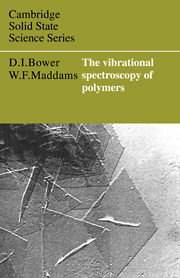Book contents
- Frontmatter
- Contents
- Preface
- 1 Introduction
- 2 Symmetry and normal modes of vibration
- 3 The vibrational modes of polymers
- 4 Infrared and Raman spectra
- 5 The characterization of polymers
- 6 The microstructure of polymers
- References for chapters 5 and 6
- A note on the use of the indexes
- Index of spectra illustrated
- Index of point groups
- Index of group modes
- Index of polymers
- Main index
4 - Infrared and Raman spectra
Published online by Cambridge University Press: 05 May 2010
- Frontmatter
- Contents
- Preface
- 1 Introduction
- 2 Symmetry and normal modes of vibration
- 3 The vibrational modes of polymers
- 4 Infrared and Raman spectra
- 5 The characterization of polymers
- 6 The microstructure of polymers
- References for chapters 5 and 6
- A note on the use of the indexes
- Index of spectra illustrated
- Index of point groups
- Index of group modes
- Index of polymers
- Main index
Summary
Semiclassical treatment of origins of spectra
Polarizability tensors and dipole moments
In this section we explain the origins of infrared absorption and Raman scattering, using as far as possible the ideas of classical physics. Quantum mechanics is introduced only where its use makes the treatment easier or where classical physics is inadequate for explaining a phenomenon or deriving a result. In addition to an explanation of the origins of the effects, an explanation is also given of the selection rules which determine which modes of vibration are actually active for infrared or Raman spectroscopy. Since infrared absorption and Raman scattering involve the interaction of molecules with electromagnetic waves, in particular with the oscillating electric field of the waves, it is necessary to consider the electrical properties of the molecules. We begin by defining the molecular polarizability tensor.
Imagine first a non-vibrating molecule which belongs to one of the point groups D2, D2h, D2d or C2v. For such a molecule the intersections of the symmetry elements define a unique set of three mutually perpendicular axes, which will be called Oxyz. The molecule consists of a large number of charged particles, the nuclei and the electrons, but is electrically neutral overall. If a steady electric field E is applied to the molecule in a direction parallel to one of the reference axes it will cause a redistribution of the charges in the molecule so that the molecule attains a net electric dipole moment, or undergoes a change in an already existing dipole moment, of amount µ.
- Type
- Chapter
- Information
- The Vibrational Spectroscopy of Polymers , pp. 107 - 161Publisher: Cambridge University PressPrint publication year: 1989



